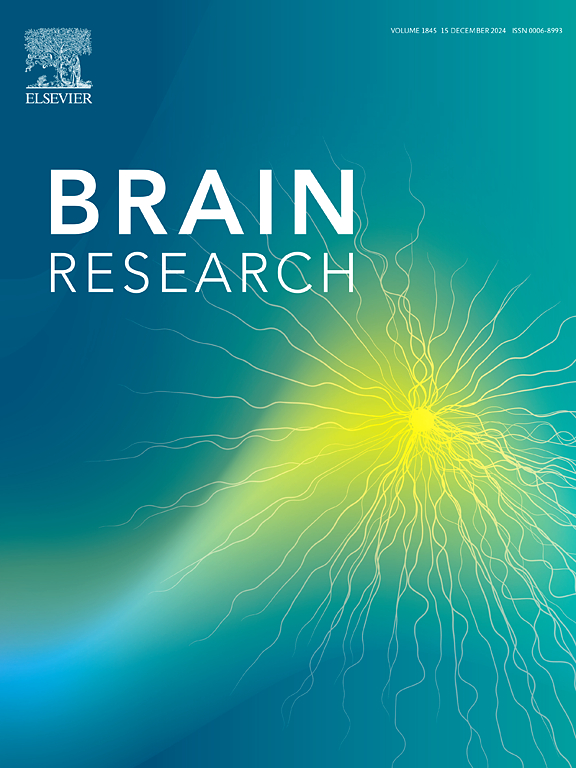Combination of rTMS and oxytocin agonist attenuate depression-like behavior after postpartum depression in mice
IF 2.7
4区 医学
Q3 NEUROSCIENCES
引用次数: 0
Abstract
The Diagnostic and Statistical Manual of Mental Disorders (DSM-5) categorizes postpartum depression (PPD) as a subtype of Major Depressive Disorder (MDD) with peripartum onset, generally arising within the initial trimester following delivery. This acute psychiatric condition is characterized by feelings of worthlessness, insomnia, extreme anxiety, or maternal neglect. Intranasal oxytocin (OT) and transcranial magnetic stimulation (TMS) have the potential to address impaired social cognition; nonetheless, their neuronal underpinnings, along with their safety and efficacy, are little comprehended. This study examines the effects of rTMS stimulation with an oxytocin agonist or antagonist in a PPD model. We employed the maternal separation with early weaning (MSEW) strategy for 21 days to attain our objective. Oxytocin acetate (agonist) and atosiban (antagonist) were administered by injection twice daily for three consecutive days following the model according to the established protocol. A single session of rTMS involved the application of high-frequency stimulation (20 Hz) one hour following the final injection. Behavioral testing and brain collection were conducted 12 h post-rTMS. The results indicated that treatment with OT followed by rTMS stimulation decreased neuronal cell death and microglial activation, meanwhile enhancing synaptic plasticity through the upregulation of PSD95, Synapsin I, and Synaptophysin. Simultaneously, both OT therapy and repetitive transcranial magnetic stimulation demonstrated a significant capacity to alter autophagy activity and astrocyte function. Nonetheless, OTA therapy followed by rTMS did not exhibit the same pattern of outcomes. Our findings indicate that the combination of rTMS stimulation and an oxytocin agonist in a PPD model may mitigate depression-like behavior.
rTMS联合催产素激动剂可减轻小鼠产后抑郁后的抑郁样行为。
精神疾病诊断与统计手册(DSM-5)将产后抑郁症(PPD)归类为围产期发病的重度抑郁症(MDD)的一种亚型,通常发生在分娩后的最初三个月。这种急性精神疾病的特点是无价值感、失眠、极度焦虑或母亲忽视。鼻内催产素(OT)和经颅磁刺激(TMS)有可能解决社会认知障碍;然而,它们的神经基础,以及它们的安全性和有效性,很少被理解。本研究在PPD模型中检测了催产素激动剂或拮抗剂的rTMS刺激的效果。我们采用母亲分离与早期断奶(MSEW)策略21 天来实现我们的目标。在建立模型后,按既定方案每日两次注射催产素醋酸酯(激动剂)和阿托西班(拮抗剂),连续3天。单次rTMS包括在最后一次注射后一小时应用高频刺激(20 Hz)。在rtms后12 h进行行为测试和脑采集。结果表明,OT后rTMS刺激可减少神经元细胞死亡和小胶质细胞活化,同时通过上调PSD95、Synapsin I和Synaptophysin来增强突触可塑性。同时,OT治疗和重复经颅磁刺激都显示出显著的改变自噬活性和星形胶质细胞功能的能力。然而,OTA治疗后的rTMS并没有表现出相同的结果模式。我们的研究结果表明,在PPD模型中,rTMS刺激和催产素激动剂的结合可能会减轻抑郁样行为。
本文章由计算机程序翻译,如有差异,请以英文原文为准。
求助全文
约1分钟内获得全文
求助全文
来源期刊

Brain Research
医学-神经科学
CiteScore
5.90
自引率
3.40%
发文量
268
审稿时长
47 days
期刊介绍:
An international multidisciplinary journal devoted to fundamental research in the brain sciences.
Brain Research publishes papers reporting interdisciplinary investigations of nervous system structure and function that are of general interest to the international community of neuroscientists. As is evident from the journals name, its scope is broad, ranging from cellular and molecular studies through systems neuroscience, cognition and disease. Invited reviews are also published; suggestions for and inquiries about potential reviews are welcomed.
With the appearance of the final issue of the 2011 subscription, Vol. 67/1-2 (24 June 2011), Brain Research Reviews has ceased publication as a distinct journal separate from Brain Research. Review articles accepted for Brain Research are now published in that journal.
 求助内容:
求助内容: 应助结果提醒方式:
应助结果提醒方式:


